-
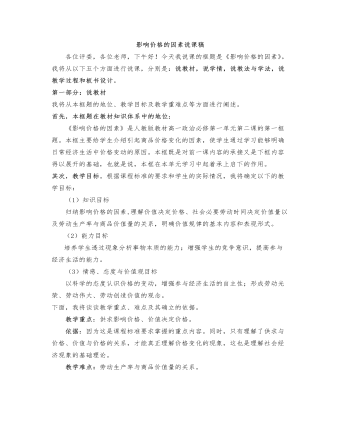
人教版高中政治必修1影响价格的因素说课稿
第一部分:说教材我将从本框题的地位、教学目标及教学重难点等方面进行阐述。首先,本框题在教材知识体系中的地位:《影响价格的因素》是人教版教材高一政治必修第一单元第二课的第一框题。本框主要给学生介绍引起商品价格变化的因素,使学生通过学习能够明确日常经济生活中价格变动的原因。本框既是对前一课内容的承接又是下框内容得以展开的基础,也就是说,本框在本单元学习中起着承上启下的作用。其次,教学目标。根据课程标准的要求和学生的实际情况,我将确定以下的教学目标:(1)知识目标归纳影响价格的因素,理解价值决定价格、社会必要劳动时间决定价值量以及劳动生产率与商品价值量的关系,明确价值规律的基本内容和表现形式。(2)能力目标培养学生透过现象分析事物本质的能力;增强学生的竞争意识,提高参与经济生活的能力。
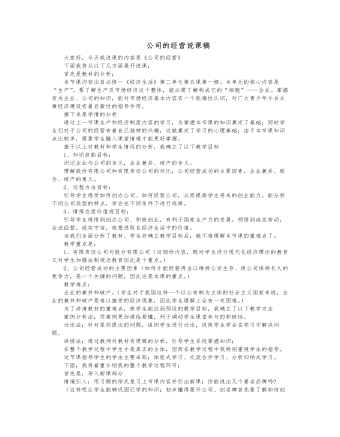
人教版高中政治必修1公司的经营说课稿
l意义(这里突破难点的方式手段——举典型例;结合时事;讨论。演绎归纳法运用,引导学生对各种感性材料进行分析与归纳,形成一定的理性认识,做到理论与实际的紧密结合,提高学生的抽象思维能力。)接下来呢是课堂小结,引导学生根据板书巩固知识。(这里我运用的是提纲式板书:这种形式的板书能够突出课文的重点,便于学生抓住要领、把握内容、加深印象,培养学生的分析概括能力。)布置作业:也就是教学评价环节引导学生课后搜集某个公司集团发展历程,并做一定思考,下节课和大家交流。(这样设计呢这样设计旨在培养学生的实践能力和动手操作能力,加深对知识的理解)谢谢大家,我的说课就到这里。恳请大家批评指正。板书设计:公司的经营一、公司的类型1、企业的含义2、公司的含义3、公司的类型:有限责任公司和股份有限公司
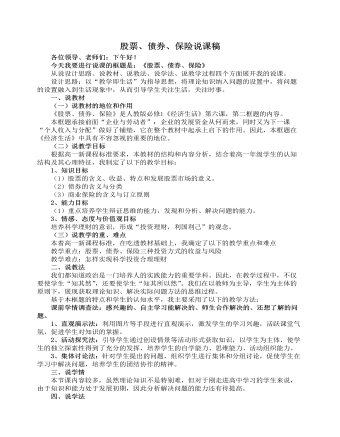
人教版高中政治必修1股票与债券说课稿
一、说教材(一)说教材的地位和作用《股票、债券、保险》是人教版必修1《经济生活》第六课,第二框题的内容。本框题承接前面“企业与劳动者”:企业的发展资金从何而来,同时又为下一课“个人收入与分配”做好了铺垫,它在整个教材中起承上启下的作用。因此,本框题在《经济生活》中具有不容忽视的重要的地位。(二)说教学目标根据高一新课程标准要求,本教材的结构和内容分析,结合着高一年级学生的认知结构及其心理特征,我制定了以下的教学目标:1、知识目标(1)股票的含义、收益、特点和发展股票市场的意义。(2)债券的含义与分类(3)商业保险的含义与订立原则2、能力目标(1)重点培养学生辩证思维的能力,发现和分析、解决问题的能力。3、情感、态度与价值观目标培养科学理财的意识,形成“投资理财,利国利己”的观念。(三)说教学的重、难点本着高一新课程标准,在吃透教材基础上,我确定了以下的教学重点和难点

人教版高中政治必修1新时代的劳动者说课稿
第一环节:关于劳动光荣和就业的意义。这两个问题学生在自主阅读的基础上,教师设疑,给出两个人物事迹,一是农民工刘俊刚把青春献给第二个家乡的城市美容师;一是北大学子李彦宏自主创业,创建百度公司,启发学生比较、思考。很多学生倾向于要做李彦宏,教师则适时引导:难道清洁工的劳动不重要吗?经过辩论,归纳出劳动和就业的意义。接着利用教材中李师傅的事例,进行问题探究,“李师傅找不到工作的原因是什么?”从主客观两方面分析,带着问题进入到下一环节学习。第二环节:突出重点。多媒体展示:通过数字的列举及对占有材料的分析,既看到了我国就业形势严峻,也介绍了国家关注民生,实施积极的就业政策。在此基础上,教师启发学生归纳“我国就业严峻的原因及对策?”学生把教材理论与生活中的现实材料相结合,进行探究,得出就业形势严峻的主要原因及其相应对策。
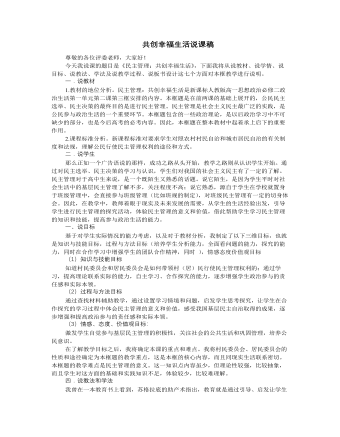
人教版高中政治必修2共创幸福生活说课稿
环节三 案例分析 突破难点我将用多媒体展示两组反映中学生参与民主管理的一些作法的图片,和教材26-27页的三个镜头,然后请同学们根据图片和材料探究以下问题: 1. 联系自身实际谈谈这些做法对我们有何启示? 2.实行农村村民自治和城市居民自治有什么意义呢? 3. 我们在实际生活中应怎么做?这样,通过图片和材料的展示,点明了公民参与民主管理的意义,以此来诱发学生已有的真切体验,感受其境,增强学生共创想和文明社区的积极性和情感。同时,我们也希望学生在学习本课的知识后,又能做到学以致用,把所学的知识真正用到社区管理中,为所在社区管理提合理建议,从而真正实现了知识从生活中来,又回到生活中去的理念。环节四课堂小结 课后延伸将用多媒体展示本节课的知识框架,并注重引导学生将今天所学新知识与前面知识联系起来,帮助学生从宏观上把握各知识点之间的关系,有利于学生理解记忆,以此来帮助教师在第一时间掌握学生学习信息的反馈,同时培养学生归纳分析能力、概括能力。
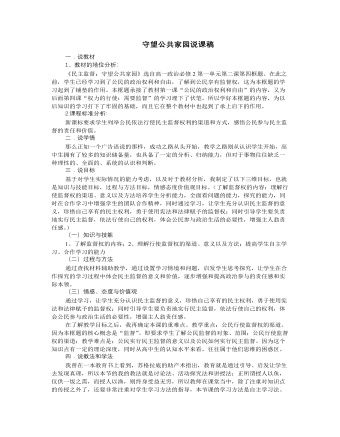
人教版高中政治必修2守望公共家园说课稿
环节四 课堂小结 巩固知识本节课我采用线索性的板书,整个知识结构一目了然,为了充分发挥学生在课堂的主体地位,我将课堂小结交由学生完成,请学生根据课堂学习的内容,结合我的板书设计来进行小结,以此来帮助教师在第一时间掌握学生学习信息的反馈,同时培养学生归纳分析能力、概括能力。环节五 情景回归,情感升华我的实习指导老师告诉过我们,政治这一门学科要从生活中来到生活去,所以在课堂的最后让学生考察自己所在社区存在的问题,然后制定监督方案,以此培养学生对理论的实际运用能力,同时检验他们对知识的真正掌握情况,以此达到情感的升华,本节课,我根据建构主义理论,强调学生是学习的中心,学生是知识意义的主动建构者,是信息加工的主体,要强调学生在课堂中的参与性、以及探究性,不仅让他们懂得知识,更让他们相信知识,并且将知识融入到实践当中去,最终达到知、情、意、行的统一。
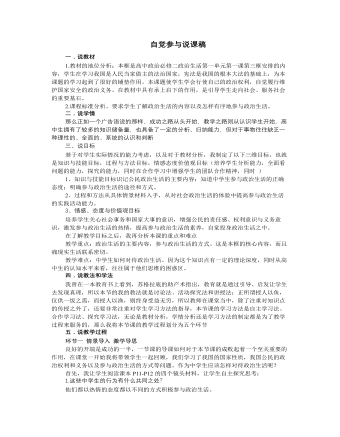
人教版高中政治必修2自觉参与说课稿
1.必须明确政治生活的作用 (政治生活与经济生活、文化生活是相辅相成的。政治生活直接影响到人民民主的实现程度,影响全体人民利益,也会影响我们的经济生活、文化生活。)2.需要学习政治知识 (5个有助于)3.需要参加政治实践活动。 (参加政治实践的途径;参加政治实践的意义)(通过情景问题,形成学生如何参与政治生活的方法;通过解决问题,培养学生解决问题的能力和发散思维的能力。)环节四 课堂小结 巩固知识本节课我采用线索性的板书,整个知识结构一目了然,为了充分发挥学生在课堂的主体地位,我将课堂小结交由学生完成,请学生根据课堂学习的内容,结合我的板书设计来进行小结,以此来帮助教师在第一时间掌握学生学习信息的反馈,同时培养学生归纳分析能力、概括能力。
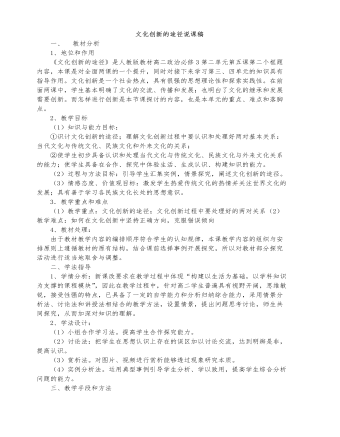
人教版高中政治必修3文化创新的途径说课稿
一、 教材分析1、地位和作用《文化创新的途径》是人教版教材高二政治必修3第二单元第五课第二个框题内容,本课是对全面两课的一个提升,同时对接下来学习第三、四单元的知识具有指导作用。文化创新是一个社会热点,具有很强的思想理论性和探索实践性。在前面两课中,学生基本明确了文化的交流、传播和发展;也明白了文化的继承和发展需要创新。而怎样进行创新是本节课探讨的内容,也是本单元的重点、难点和落脚点。2、教学目标(1)知识与能力目标:①识计文化创新的途径;理解文化创新过程中要认识和处理好两对基本关系:当代文化与传统文化、民族文化和外来文化的关系;②使学生初步具备认识和处理当代文化与传统文化、民族文化与外来文化关系的能力;使学生具备在合作、探究中体验生活、生成认识、构建知识的能力。
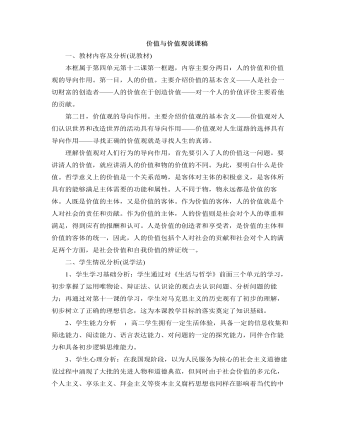
人教版高中政治必修4价值与价值观说课稿(二)
二、学生情况分析(说学法)1、学生学习基础分析:学生通过对《生活与哲学》前面三个单元的学习,初步掌握了运用唯物论、辩证法、认识论的观点去认识问题、分析问题的能力;再通过对第十一课的学习,学生对马克思主义的历史观有了初步的理解,初步树立了正确的理想信念,这为本课教学目标的落实奠定了知识基础。 2、学生能力分析 :高二学生拥有一定生活体验,具备一定的信息收集和筛选能力、阅读能力、语言表达能力、对问题的一定的探究能力,同伴合作能力和具备初步逻辑思维能力。3、学生心理分析:在我国现阶段,以为人民服务为核心的社会主义道德建设过程中涌现了大批的先进人物和道德典范,但同时由于社会价值的多元化,个人主义、享乐主义、拜金主义等资本主义腐朽思想也同样在影响着当代的中学生。

人教版高中英语必修1Journey Down the Mekong说课稿
2. let the Ss complete the forms paragraph by paragraph. Purpose here is to help Ss to get the habit of reading a passage as a whole, and pay attention to the organization of the text, as a result the Ss will fully understand the whole passage.3. ask Ss to retell the passage with the help of the key words in the form.Since the Ss in the class are in different levels, so I let them to fill in the blank to understand the meaning of the words and phrases better. ( That’s all for the while-reading. Now let’s move to the fifth step.)Step V: Post-reading (10mins) ---DiscussionIn this part students are asked to discuss in groups and list Wang Kun’s and Wang Wei’s attitudes about the trip. After that, Ss are encouraged to express their attitudes with the whole class. Collect their answers and don’t forget to praise them even if their answers may not be perfect.In this activity, discussion provides a vivid and active learning environment for Ss to communicate in English with newly learned language items. (Finally it comes to the homework.)StepⅥ: Homework (1min)1. Ss are required to read the text again after class and figure out the meaning of some complex sentences.2. Do the exercises on P19; This can help Ss to consolidate what they’ve learnt and make preparation for the next lessonPart4. Blackboard design.(说板书设计)On the top, there is the title of this lesson. On the left, there are main ideas for each paragraph. On the right, there are some new words and expressions.Unit 3 Travel journalJourney down the MekongMain idea of each para.:Para1: deciding to take a great bike trip along the Mekong river.Para2: Different attitudes between Wang kun and Wang wei.

人教版高中英语必修1Anne's best friend说课稿
Step 7 Language points 1.Vocabulary (1) go through (2) set down (3) a series of (4) on purpose (5) in order to (6)at dusk (7)entirely (8)face to face 2.Important sentences (1)…I’ve grown so crazy about everything to do with nature. (2)There was a time when … (3)I stayed awake on purpose until … (4)It was the first time … that I’d seen the night … (5)It’s no pleasure looking through … Purpose: 1.Master the required vocabulary and sentence structures. 2.Use them freely. Step 8 Consolidation 1.Find out the topic sentences 2.Retell the text according to the topic sentences Purpose: I want to know if my students understand the text. Step 9 Discussion Imagine you have to go into hiding like Anne and her family, what would you miss most? Giveyour reasons. Purpose: Train Ss’ oral English ability. Step 10 Homework Write an article on Friends. Purpose: 1. Improve the Ss’ writing ability. 2 Train the Ss’ ability of self—teaching and looking up information by themselves. Part 5 Blackboard design(说板书设计)Unit 1 Friendship Reading Anne’s Best Friend 1.Main idea of each paragraph: Para. 1 Anne made her diary her best friend. Para .2 Anne wrote her feelings in her diary. Para .3 Anne missed nature. Para.4 Anne saw the night face to face Para.5 Anne wanted to experience nature outdoors. 2.Listening: Exx.1 P3 3.Discussion: Exx.3 P3 Purpose: 1.Make Ss familiar with the passage 2.Make the design inductive, instructive and artistic.

人教版高中英语必修1English around the world说课稿
(3)v. 给:提出;展现,显现present sb. with sth. ; present sth. to sb. 把. . 交给;颁发;授予present sth. (for sth. )/present sth. to sb. e. g. Om his birthday, his friends presented him a collection of stamps. 在他生日时,他的朋友们送给他一套邮票作为礼物。The sword was presented by the family to the museum. 这家人把宝剑捐赠给了博物馆。The committee will present the final report to Parliament in June. 委员会将在六月向议会提交最后的报告。You need to present yourself better. 你需要更善于展现自己。It is essential that we present a united front. 至关重要的是我们要表现得更加团结。Step 4 ConsolidationT:Now that we have got a general idea of these words and phrases. Lets make up some sentences using them to master them. Suggested sentences:1. Your duties include typing letters and answering the telephone. 2. It is one of the greatest roles that she has played. 3. A large number of people have applied for the job. 4. The number of the panda is declining. 5. I'11 go there, even if I have to walk. 6. He came up to me to ask for a light. 7. The novel is about a family who can't communicate with each other. 8. He based his plan on interests of most people. 9. Why doesn't he make use of his singing talent?Step 5 Summary and homeworkT:Today we dealt with several new words and phrases. After class I hope that youcan read them again and again to keep them in mind. That's all for today. You aredismissed.

人教版高中英语必修3Canada-the true north说课稿4篇
Good afternoon, teachers, It’s my great pleasure to be here sharing my lesson with you.The content of my lesson is Senior English Book 3 Unit 5 Canada —— “The true North”.I’ll be ready to begin this lesson from five parts. Analysis of the teaching material,the teaching methods,the studying methods, the teaching procedure,and Blackboard design.First, let me talk about the teaching material.Part 1 Teaching Material:This unit is about the introduction of Canada. By studying of this unit,we’ll enable the students to learn the geography, population, main cities, and natural beauty, natural resources of Canada. Through the training of the unit, it also requires students to learn some Language skills such as the expressions of position and emotions.So it plays an important part in the English teaching in this book.After studying the teaching material and analyzing the rule of children’s growing of mind,I think the teaching aims are the followings:1.Knowledge objects:(1) make the students learn some new words and phrases(2) make the students understand the content of the lesson.2.Ability objects:(1)To develop the Ss’ abilities of listening, speaking, reading and writing. Especially reading and speaking ability.(2) learn to talk about the characters of Canada in English(3)To train the Ss’ ability of working in pairs.3.Emotion objects:(1)Enable students to understand the characters of Canada..(2)Stimulate Ss to work hard to make China stronger.Part 2 Teaching Methods:I think helping students learn to master new words and phrases and improve the students’ reading and speaking ability is import and the difficult.According to the analysis of the teaching material and the import points and the difficult points,I will use the following teaching methods : question-guiding approach; fast-reading and careful reading; multi-media teaching methods; discussion

人教版高中英语必修5First aid说课稿6篇
In this class, I have 3 teaching aims, that is, knowledge aims, ability aims and emotion aims.1) Knowledge-Teach students new words and expressions, such as temporary, bleed,sprain choke, first aid, fall ill and so on.-Enable students to have a better understanding for some basic knowledge of first aid.2) Ability-Train students’ speaking, reading and writing abilities by different teaching activities, such as skimming, comprehending, team work, role play, retelling and writing.-Develop students’ reading strategy on how to move general idea to specific information.3) Emotion-Promote students’ awareness of giving first aid.- Cultivate students’ creativities.Then let’s come to my teaching methods and activities.III. Teaching methods and activities:To achieve different teaching aims, various kinds of teaching methods and activities will be adopted throughout this period, such as TBL (task-based learning), skimming, team work, brainstorm and others, which can offer students opportunities to fulfill tasks in which they can use language to achieve a specific outcome.IV. Teaching aids:Computer and blackboardV. Teaching important points:1) Make students have a clear mind for the structure of the text.2) Help students understand the theme of the text.VI. Teaching difficulties:1) So many new words may affect students’ understanding.2) How to get students to know about the functions of the skin and thecauses, characteristics and treatments for different degree burns,and the knowledge about giving first aid. VII. Blackboard design:
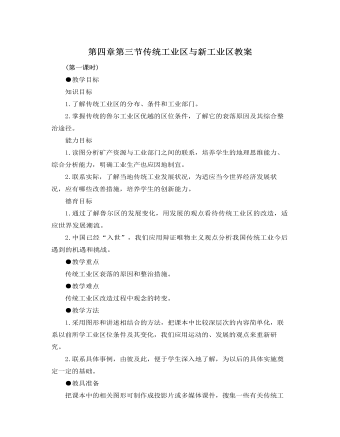
人教版新课标高中地理必修2第四章第三节传统工业区与新工业区教案
知识目标1.了解传统工业区的分布、条件和工业部门。2.掌握传统的鲁尔工业区优越的区位条件,了解它的衰落原因及其综合整治途径。能力目标1.读图分析矿产资源与工业部门之间的联系,培养学生的地理思维能力、综合分析能力,明确工业生产也应因地制宜。2.联系实际,了解当地传统工业发展状况,为适应当今世界经济发展状况,应有哪些改善措施,培养学生的创新能力。德育目标1.通过了解鲁尔区的发展变化,用发展的观点看待传统工业区的改造,适应世界发展潮流。2.中国已经“入世”,我们应用辩证唯物主义观点分析我国传统工业今后遇到的机遇和挑战。
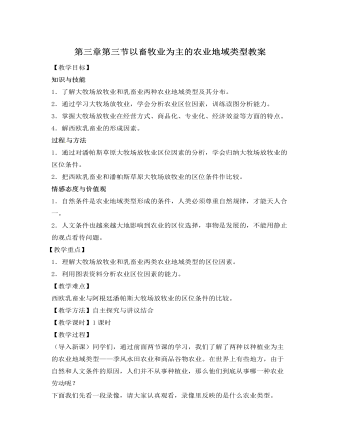
人教版新课标高中地理必修2第三章第三节以畜牧业为主的农业地域类型教案
知识与技能1.了解大牧场放牧业和乳畜业两种农业地域类型及其分布。2.通过学习大牧场放牧业,学会分析农业区位因素,训练读图分析能力。3.掌握大牧场放牧业在经营方式、商品化、专业化、经济效益等方面的特点。4.解西欧乳畜业的形成因素。过程 与方法1.通过对潘帕斯草原大牧场放牧业区位因素的分析,学会归纳大牧场放牧业的区位条件。2.把西欧乳畜业和潘帕斯草原大牧场放牧业的区位条件作比较。情感态度与价值观1.自然条件是农业地域类型形成的条件,人类必须尊重自然规律,才能天人合一。2.人文条件也越来越大地影响到农业的区位选择,事物是发展的,不能用静止的观点看待问题。【教学重点】1.理解大牧场放牧业和乳畜业两类农业地域类型的区位因素。2.利用图表资料分析农业区位因素的能力。
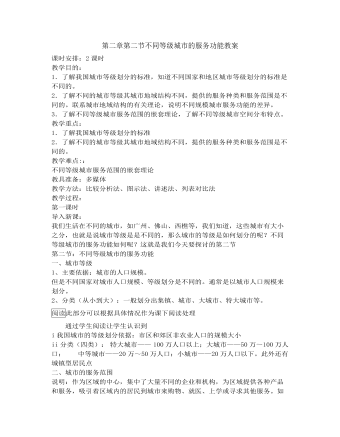
人教版新课标高中地理必修2第二章第二节不同等级城市的服务功能教案
1.了解我国城市等级划分的标准,知道不同国家和地区城市等级划分的标准是不同的。2.了解不同的城市等级其城市地域结构不同,提供的服务种类和服务范围是不同的。联系城市地域结构的有关理论,说明不同规模城市服务功能的差异。3.了解不同等级城市服务范围的嵌套理论,了解不同等级城市空间分布特点。教学重点:1.了解我国城市等级划分的标准2.了解不同的城市等级其城市地域结构不同,提供的服务种类和服务范围是不同的。教学难点::不同等级城市服务范围的嵌套理论教具准备:多媒体教学方法:比较分析法、图示法、讲述法、列表对比法教学过程:第一课时导入新课:我们生活在不同的城市,如广州、佛山、西樵等,我们知道,这些城市有大小之分,也就是说城市等级是是不同的,那么城市的等级是如何划分的呢?不同等级城市的服务功能如何呢?这就是我们今天要探讨的第二节
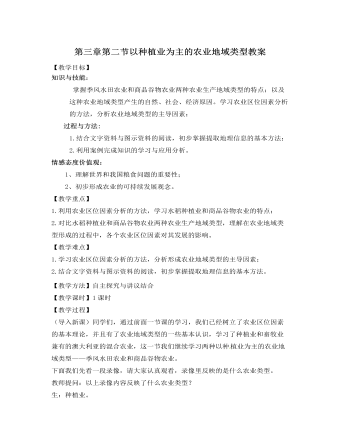
人教版新课标高中地理必修2第三章第二节以种植业为主的农业地域类型教案
【教学重点】1.利用农业区位因素分析的方法,学习水稻种植业和商品谷物农业的特点;2.对比水稻种植业和商品谷物农业两种农业生产地域类型,理解在农业地域类型形成的过程中,各个农业区位因素对其发展的影响。【教学难点】1.学习农业区位因素分析的方法,分析形成农业地域类型的主导因素;2.结合文字资料与图示资料的阅读,初步掌握提取地理信息的基本方法。【教学方法】自主探究与讲议结合【教学课时】1课时【教学过程】(导入新课)同学们,通过前面一节课的学习,我们已经树立了农业区位因素的基本理论,并且有了农业地域类型的一些基本认识,学习了种植业和畜牧业兼有的澳大利亚的混合农业,这一节我们继续学习两种以种 植业为主的农业地域类型——季风水田农业和商品谷物农业。
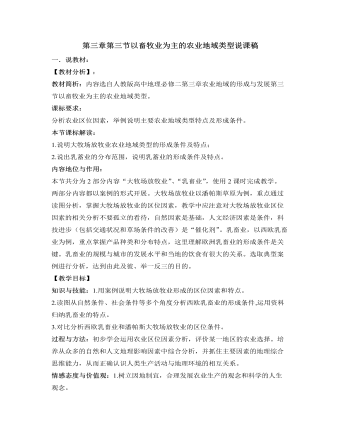
人教版高中地理必修2第三章第三节以畜牧业为主的农业地域类型说课稿
1.导入新课:通过视频“阿根廷的潘帕斯草原”,引起学生的兴趣,进而引出新的学习内容——以畜牧业为主的农业地域类型。2.新课讲授:第一课时,首先通过展示“世界大牧场放牧业分布图”,引出对大牧场放牧业的初步认识,了解其分布范围;然后通过展示“潘帕斯草原的地形图”“气候图”和“牧牛业景观图”,讨论分析大牧场放牧业形成的区位条件,并进行案例分析,学习该种农业的特点;最后,理论联系实际,展示:“中国地形图”“气候图”“人口图”“交通图”和“内蒙古牧区图”,分组讨论我国内蒙古地区能否采用潘帕斯草原大牧场放牧业的生产模式。第二课时,首先通过设问顺利从大牧场放牧业转入乳蓄业,通过讲述让学生了解乳蓄业的概念;然后通过展示世界乳畜业分布图,了解乳蓄业主要分布在哪些地区;接着,通过西欧乳蓄业的案例分析,得到乳蓄业发展的区位因素及其特点。
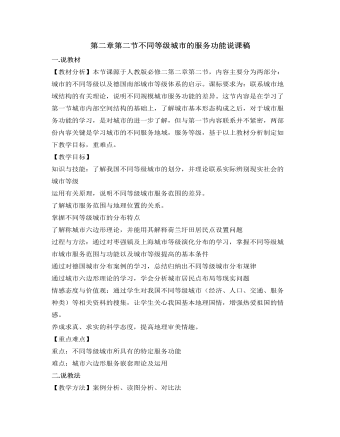
人教版高中地理必修2第二章第二节不同等级城市的服务功能说课稿
【教学目标】知识与技能:了解我国不同等级城市的划分,并理论联系实际辨别现实社会的城市等级运用有关原理,说明不同等级城市服务范围的差异。了解城市服务范围与地理位置的关系。掌握不同等级城市的分布特点了解称城市六边形理论,并能用其解释荷兰圩田居民点设置问题过程与方法:通过对枣强镇及上海城市等级演化分布的学习,掌握不同等级城市城市服务范围与功能以及城市等级提高的基本条件通过对德国城市分布案例的学习,总结归纳出不同等级城市分布规律通过城市六边形理论的学习,学会分析城市居民点布局等现实问题情感态度与价值观:通过学生对我国不同等级城市(经济、人口、交通、服务种类)等相关资料的搜集,让学生关心我国基本地理国情,增强热爱祖国的情感。养成求真、求实的科学态度,提高地理审美情趣。